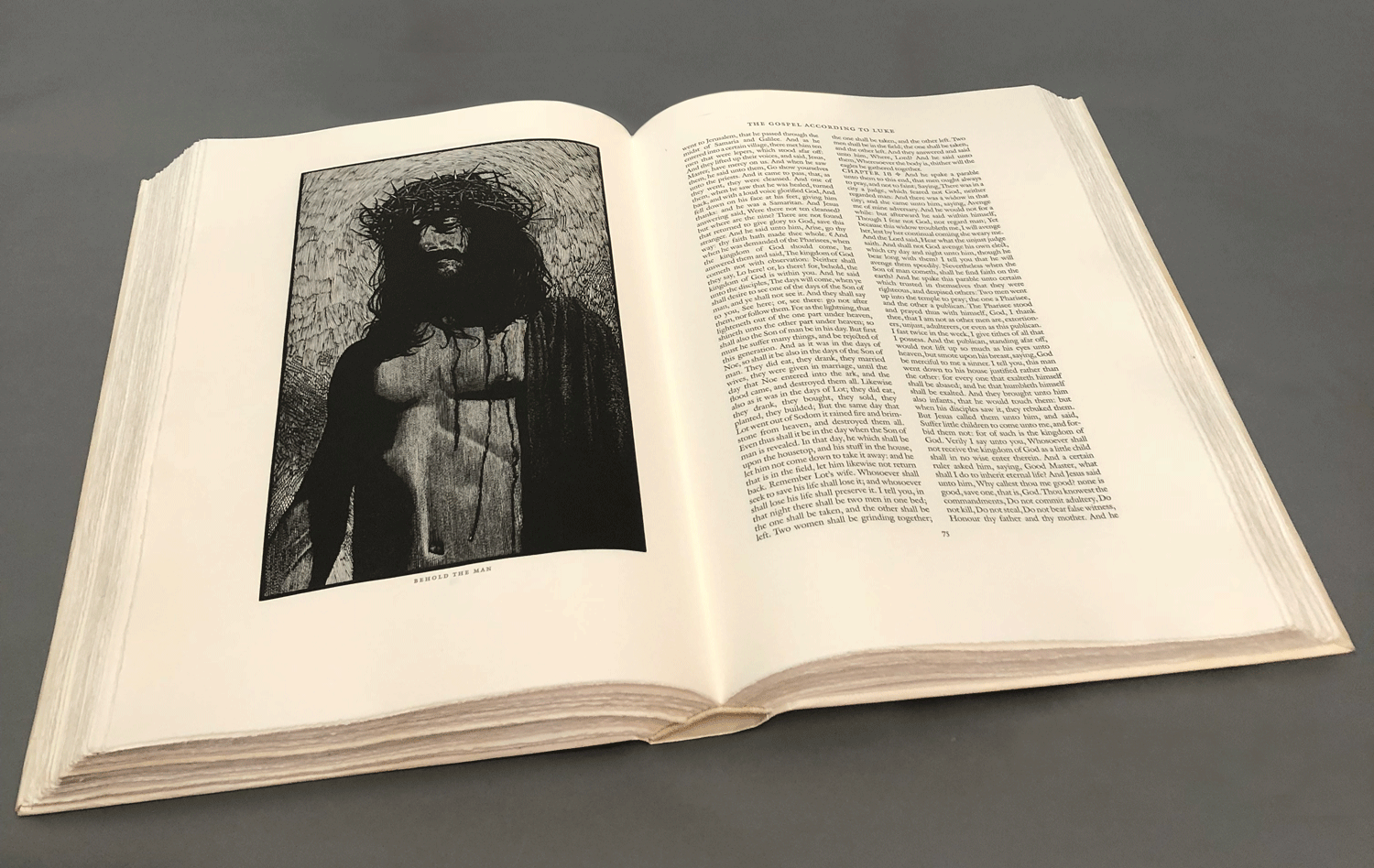About The Pennyroyal Caxton Bible
Bibles have been the crowning masterpieces of the world’s greatest calligraphers, typographers, printers and illustrators for centuries. One could walk the history of printing on the spines of great Bibles—from Gutenberg’s to Baskerville’s, to the peerless Doves Press Bible of 1903, and Bruce Rogers’ Oxford Lectern Bible of 1935.
As the new millennium approached, Barry Moser turned his attention to the King James Bible. Working with a team of expert craftsmen and scholars for more than four years, Moser produced the Pennyroyal Caxton Bible. It is the only twentieth century bible with illustrations for every book of both the Old and New Testaments that were invented and executed by a single artist. There are two hundred and thirty-two engraved illustrations that range from full-page illustrations that measure 7.25 x 11.5 inches to part-page illustrations as small as 3.5 x 5 inches.
❧
Following Moser’s design, Bradley Hutchinson composed and printed the pages at his shop, Digital Letterpress, in Austin, Texas. The computer-generated type was translated into polymer printing plates and printed letterpress, a process combining the best of traditional printing techniques with contemporary typographic technology. The trim size is 11 by 16 inches.
The type is Matthew Carter’s 1978 Galliard. It was modeled after the sixteenth century letterforms of Robert Granjon, and was refitted by Carter specially for this project. He also designed a Hebrew alphabet, LeBe, that is seen here for the first time. The titles and versal letters are set in Carter’s Mantinia.
John “Fud” Benson, the peerless letter cutter best known for his lettering on the Vietnam Veterans Memorial, designed three display words for the project: GOD that appears on the opening spread of the book of Genesis; CHRIST that appears on the opening spread of the Gospel according to Matthew; and AMEN, the final word of the book of Revelation.
Julian Waters contributed the calligraphic treatments of the tiles that are stamped in gold leaf on the covers. He also gilded the word God on the first page of the book of Genesis.
The paper for the Pennyroyal Caxton Bible is Zerkall Bible, a white, mould-made, wove sheet with a vellum finish. It was manufactured specifically for this project by the Zerkall Paper Mills in the small village of Zerkall, Germany, on the River Kall. It bears the watermark of Pennyroyal Caxton: a pomegranate (symbolic of the resurrection and of the spreading of the gospel) atop an arrangement of the initials P and C.
Thirty deluxe copies of the Pennyroyal Caxton Bible were printed on a handmade sheet that was custom-made by Kathryn and Howard Clark at Twinrocker handmade paper in Brookston, Indiana.
The bindings of the primary edition are full limp vellum and were built in the combined workshops of Claudia Cohen and Sarah Creighton in Easthampton, Massachusetts. “The Holy Bible” is stamped in gold on the front covers and spines of both volumes. Each of the two volumes are protected by a linen-covered clamshell tray-case.
The bindings of the deluxe edition were also built by Cohen and Creighton. Each copy comprises seven volumes: volumes one through five are the five sections of the Bible, each section bound in limp vellum and laid into a clamshell tray-case. The sixth volume is a complete set of the engravings printed by Harold McGrath on hand-made Japanese Kitakata. These suites include all the engravings, plus proofs of rejected prints as well. Each print is signed by Moser. Volume seven contains three items: a pencil study for one of the images, a platinum print of a photograph based on the drawing, and the original engraved block of that image.
Pennyroyal Caxton is a partnership between Barry Moser and Bruce Kovner, a generous patron of the arts.
A full prospectus on the Pennyroyal Caxton Bible is available upon request.
appreciations
“The sample page from your Bible is splendid. It’s the sort of thing that makes type designers think their work has not been in vain.” —Matthew Carter to Barry Moser, December 1995
“Moser’s work is never less than dazzling and has an enigmatic profundity that sets it apart.” —John Ashbery, Newsweek
“In his narrative illustrations Mr. Moser gives his own reading, conducts his own orchestra.” —Peter Neumeyer, New York Times
“The Pennyroyal Caxton Bible project seems at once anachronistic, megalomaniacal and inspirational. Interpreting out most cherished and profound convictions in art is a project of uncertain success. Doing so at a time and place when those convictions are no longer universal and interpretations are easy targets of sectarian politics and secular disdain is even more daunting a project. His single image [of Jonah cast into the sea] makes me certain there are visions in [the Bible] which only a modern artist can embody.” —Ellen B. Cutler, Cultural Dimensions, Hartford, Connecticut, March 1998
“I for one cannot look upon the images that make up the crucifixion without feeling the agony of that sacrifice. And something else. Call it the price god’s own son paid to buy back the human race, including—it would seem—the man who wrote these words and etched line by line these sacred images.” —Paul Mariani, Image: A Journal of the Arts & Religion, January 1999
“Moser has created engravings with the brooding power of magic realism ...[his] images aren’t the usual biblical clichés...some of his indelibly beautiful engravings are downright disturbing.” — Malcom Jones Jr., Newsweek

